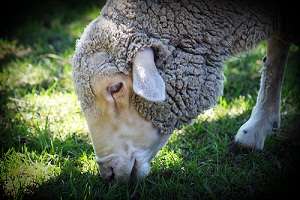Albany scientists produce sheep vaccine first

A world-first vaccine more than 25 years in the making is being developed in Albany and could be available in commercial quantities by the end of next year.
The vaccine, created in collaboration between researchers at the Department of Agriculture and Food's Albany district office and the Moredun Research Institute in Edinburgh, Scotland, will guard against the world's most severe sheep and goat parasite–Barbers pole worm (Haemonchus contortus).
Barbers pole worm, named after its red and white striped appearance, occurs in the fourth stomach of sheep and goats from Kalbarri to Esperance in WA, as well as other pastoral areas of Australia and overseas.
Grazing animals can contract Barbers pole worms by ingesting microscopic larvae that has hatched from eggs laid in the intestinal tract of the host animal by adult worms, which are passed through faeces and migrate onto pasture.
The worms suck the blood of their host and can cause rapid death by blood loss.
Department principal veterinary parasitologist Brown Besier, who did his PhD on Barbers pole worm in 1991 and has been involved with the vaccine project since 2008, says animals are developing resistance to chemical drenches currently used to combat the worms.
He says Moredun Research Institute immunologist David Smith recently discovered it was possible to grow worms in the sheep's gut without causing ill effects.
"Field trials … over the past three years have proven the effectiveness of growing a non-lethal dose of adult worms in lamb's stomachs, which are harvested after slaughter to create the vaccine."
The process involves grinding adult worms taken from sheep's stomachs then spinning them at high speed in a centrifuge to extract a protein-rich liquid.
Dr Besier says the specific immunity-inducing antigen, which originates in the worms intestinal tracts, is then separated and becomes the basis of the vaccine.
"The vaccine stimulates the immune system so it is primed to produce antibodies to the antigenic proteins and other immunogenic cells," he says.
"When sheep become infected with Barbers pole worms the anti-Barbers pole antibodies in the bloodstream recognise the proteins in the worm as a specific foreign substance and the immune response goes into high gear, targeting the worms with immune-active cells and toxic substance.
"This kills the worm in an early stage of its development so the sheep does not suffer."
Dr Besier says the new vaccine has been registered with the Australian Pesticides and Veterinary Medical Authority and, if approved, could be on the market in commercial quantities by the end of next year.
"We don't want to get ahead of ourselves but we think we can eventually market it to five million sheep a year in Australia and then overseas."
Provided by Science Network WA


















